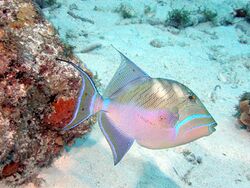Biology:Balistes vetula
| Balistes vetula | |
|---|---|

| |
| Scientific classification | |
| Domain: | Eukaryota |
| Kingdom: | Animalia |
| Phylum: | Chordata |
| Class: | Actinopterygii |
| Order: | Tetraodontiformes |
| Family: | Balistidae |
| Genus: | Balistes |
| Species: | B. vetula
|
| Binomial name | |
| Balistes vetula | |
| Synonyms | |
| |
Balistes vetula, the queen triggerfish or old wife, is a reef dwelling triggerfish found in the Atlantic Ocean. It is occasionally caught as a gamefish, and sometimes kept in very large marine aquaria.
Etymology
This fish is called cochino in Cuba,[1] and this is the probable origin of the name Bahía de Cochinos, which is known as the Bay of Pigs in English.
Description
The queen triggerfish reaches 60 cm (24 in), though most only are about half that length.[2] It is typically blue, purple, turquoise and green with a yellowish throat, and light blue lines on the fins and head.[3] It can change colour somewhat to match its surroundings, or if subjected to stress.[3]
Distribution
In the western Atlantic, it ranges from Canada to southern Brazil , and in the eastern Atlantic it is found at Ascension, Cape Verde, Azores and south to Angola.[2] It is reasonably common in Florida, the Bahamas and the Caribbean.[3]
Ecology
The queen triggerfish is typically found at coral and rocky reefs in depths of 3–30 m (9.8–98.4 ft), but it can occur as deep as 275 m (902 ft) and sometimes over areas with sand or seagrass.[2]
It preys on a variety of invertebrates, notably sea urchins.[3]
In the aquarium
As one of the largest and most aggressive of the triggerfish, this fish is rarely a good choice as a resident in a marine aquarium. It is however a hardy fish for those who can provide it with a proper environment. Because it grows so large and so quickly the minimum aquarium for this fish is a 500-gallon aquarium. Although some sources argue it can be kept in as little a tank as 125 gallons, when it achieves its adult size of two feet it is very unlikely to thrive, and will likely lead to premature death.[citation needed]
Its diet consists of invertebrates. In aquariums shrimp, squid, clams, octopus, scallops, and crab are all good choices of food.
References
- ↑ Claro, Rodolfo; García-Arteaga, Juan P.; Gobert, Bertrand; Cantelar Ramos, Karel (2004). "Situación actual de los recursos pesqueros del Archipiélago Sabana-Camagüey, Cuba" (in Spanish). Bulletin of Marine and Coastal Research (INVEMAR) 33: 49–67. ISSN 0122-9761. http://www.invemar.org.co/redcostera1/invemar/docs/Vol33/BIMC_33_03_Claro.pdf. Retrieved 14 April 2011.
- ↑ Jump up to: 2.0 2.1 2.2 Froese, Rainer and Pauly, Daniel, eds. (2012). "Balistes vetula" in FishBase. June 2012 version.
- ↑ Jump up to: 3.0 3.1 3.2 3.3 Humann, Paul; Deloach, Ned (2002). Reef Fish Identification: Florida, Caribbean, Bahamas (Third ed.). New World Publications. pp. 394. ISBN 978-1878348302.
External links
- animal-world.com Page on queen triggerfish
- Aquarium Fish: Triggerfish
- Photos of Balistes vetula on Sealife Collection
Wikidata ☰ Q302151 entry
 |


